List of Parliamentary constituencies in Buckinghamshire
The ceremonial county of Buckinghamshire, which includes the unitary authorities of Buckinghamshire and the Borough of Milton Keynes, is divided into 7 Parliamentary constituencies – 1 Borough constituency and 6 County constituencies.
Constituencies
Conservative † Labour ‡ Liberal Democrat ¤ Independent
| Constituency[nb 1] | Electorate[1] | Majority[2][nb 2] | Member of Parliament[2] | Nearest opposition[2] | Map | ||
|---|---|---|---|---|---|---|---|
| Aylesbury CC | 86,665 | 17,373 | Rob Butler † | Liz Hind ‡ | 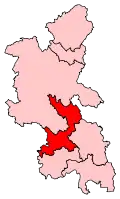 | ||
| Beaconsfield CC | 77,720 | 15,712 | Joy Morrissey † | Dominic Grieve | |||
| Buckingham CC | 83,146 | 20,411 | Greg Smith † | Stephen Dorrell ¤ | 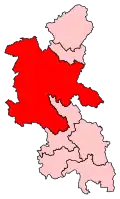 | ||
| Chesham and Amersham CC | 72,542 | 16,223 | Cheryl Gillan † | Dan Gallagher ¤ | 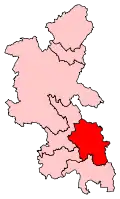 | ||
| Milton Keynes North CC | 91,545 | 6,255 | Ben Everitt † | Charlynne Pullen ‡ |  | ||
| Milton Keynes South BC | 96,363 | 6,944 | Iain Stewart † | Hannah O'Neill ‡ |  | ||
| Wycombe CC | 78,093 | 4,214 | Steve Baker † | Khalil Ahmed ‡ | 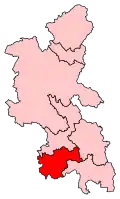 | ||
2010 Boundary Review
In the Fifth Review the Boundary Commission for England[3] proposed changes to realign constituency boundaries with the boundaries of current local government wards, and to reduce the electoral disparity between constituencies. The changes included the return of Great Missenden to Chesham and Amersham, Hazlemere to Wycombe and Aston Clinton to Buckingham. In addition, Marlow was transferred from Wycombe to Beaconsfield and Princes Risborough from Aylesbury to Buckingham. The boundary between the two Milton Keynes constituencies was realigned and they were renamed as Milton Keynes North and Milton Keynes South.
| Name | Pre-2010 boundaries | Revised name | Post-2010 boundaries |
|---|---|---|---|
|
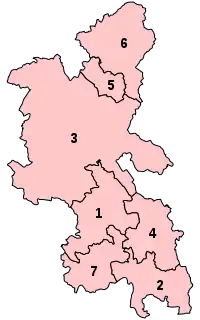 Parliamentary constituencies in Buckinghamshire |
|
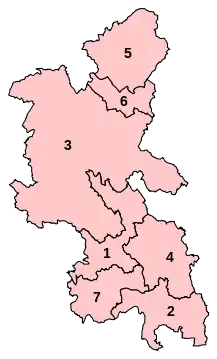 Proposed Revised constituencies in Buckinghamshire |
Proposed boundary changes
The Boundary Commission for England submitted their final proposals in respect of the Sixth Periodic Review of Westminster Constituencies (the 2018 review) in September 2018. Although the proposals were immediately laid before Parliament they were not brought forward by the Government for approval. Accordingly, they did not come into effect for the 2019 election which took place on 12 December 2019, and which was contested using the constituency boundaries in place since 2010.
Under the terms of the Parliamentary Voting System and Constituencies Act 2011, the Sixth Review was based on reducing the total number of MPs from 650 to 600 and a strict electoral parity requirement that the electorate of all constituencies should be within a range of 5% either side of the electoral quota.
On 24 March 2020, the Minister of State for the Cabinet Office, Chloe Smith, issued a written statement to Parliament setting out the Government's thinking with regard to parliamentary boundaries.[4] Subsequently, the Parliamentary Constituencies Act 2020[5] was passed into law on 14 December 2020. This formally removed the duty to implement the 2018 review and set out the framework for future boundary reviews. The Act provided that the number of constituencies should remain at the current level of 650, rather than being reduced to 600, while retaining the requirement that the electorate should be no more than +/- 5% from the electoral quota.
The Act specified that the next review should be completed no later than 1 July 2023 and the Boundary Commission formally launched the 2023 Review on 5 January 2021.[6] See 2023 Periodic Review of Westminster constituencies for further details.
Results history
Primary data source: House of Commons research briefing - General election results from 1918 to 2019[7]
2019
The number of votes cast for each political party who fielded candidates in constituencies comprising Buckinghamshire in the 2019 general election were as follows:
| Party | Votes | % | Change from 2017 | Seats | Change from 2017 |
|---|---|---|---|---|---|
| Conservative | 220,814 | 52.7% | 7 | ||
| Labour | 106,226 | 25.4% | 0 | 0 | |
| Liberal Democrats | 57,554 | 13.7% | 0 | 0 | |
| Greens | 12,349 | 2.9% | 0 | 0 | |
| Brexit | 1,286 | 0.3% | new | 0 | 0 |
| Others | 20,664 | 5.0% | 0 | ||
| Total | 418,893 | 100.0 | 7 |
Percentage votes
Note that before 1983 Buckinghamshire included the Eton and Slough areas of what is now Berkshire.
| Election year | 1922 | 1923 | 1924 | 1929 | 1931 | 1935 | 1945 | 1950 | 1951 | 1955 | 1959 | 1964 | 1966 | 1970 | 1974 (F) | 1974 (O) | 1979 | 1983 | 1987 | 1992 | 1997 | 2001 | 2005 | 2010 | 2015 | 2017 | 2019 |
|---|---|---|---|---|---|---|---|---|---|---|---|---|---|---|---|---|---|---|---|---|---|---|---|---|---|---|---|
| Conservative | 50.2 | 47.0 | 54.3 | 47.1 | 72.3 | 60.6 | 43.4 | 45.2 | 54.3 | 53.9 | 52.5 | 48.8 | 47.1 | 52.5 | 44.3 | 44.4 | 55.0 | 56.8 | 57.0 | 57.0 | 43.7 | 45.1 | 47.8 | 44.3 | 45.5 | 47.0 | 52.7 |
| Labour | 13.8 | 19.6 | 16.3 | 19.7 | 20.9 | 29.1 | 43.8 | 39.7 | 45.7 | 40.4 | 35.4 | 36.0 | 39.7 | 35.9 | 29.7 | 32.0 | 27.4 | 14.4 | 15.5 | 19.2 | 30.6 | 30.9 | 25.9 | 15.5 | 18.1 | 29.3 | 25.4 |
| Liberal Democrat1 | 36.1 | 33.4 | 29.4 | 33.1 | 6.8 | 10.3 | 12.7 | 14.7 | - | 5.7 | 12.1 | 15.2 | 13.2 | 11.7 | 25.4 | 22.5 | 15.9 | 28.5 | 27.0 | 22.1 | 21.2 | 19.9 | 21.2 | 20.9 | 6.5 | 6.4 | 13.7 |
| Green Party | - | - | - | - | - | - | - | - | - | - | - | - | - | - | - | - | - | - | * | * | * | * | * | 0.8 | 5.7 | 4.0 | 2.9 |
| UKIP | - | - | - | - | - | - | - | - | - | - | - | - | - | - | - | - | - | - | - | - | * | * | * | 6.2 | 14.9 | 3.2 | * |
| Brexit Party | - | - | - | - | - | - | - | - | - | - | - | - | - | - | - | - | - | - | - | - | - | - | - | - | - | - | 0.3 |
| The Speaker2 | - | - | - | - | - | - | - | - | - | - | - | - | - | - | - | - | - | - | - | - | - | - | - | 6.3 | 9.0 | 8.5 | - |
| Other | - | - | - | - | - | - | - | 0.4 | - | - | - | - | - | - | 0.6 | 1.1 | 1.7 | 0.4 | 0.5 | 1.8 | 4.5 | 4.0 | 5.0 | 5.9 | 0.3 | 1.6 | 5.0 |
1pre-1979: Liberal Party; 1983 & 1987 - SDP-Liberal Alliance
2Standing in Buckingham, unopposed by the 3 main parties.
* Included in Other
Accurate vote percentages for the 1918 election cannot be obtained because some candidates stood unopposed.
Seats
| Election year | 1983 | 1987 | 1992 | 1997 | 2001 | 2005 | 2010 | 2015 | 2017 | 2019 |
|---|---|---|---|---|---|---|---|---|---|---|
| Conservative | 6 | 6 | 7 | 5 | 5 | 6 | 6 | 6 | 6 | 7 |
| Labour | 0 | 0 | 0 | 2 | 2 | 1 | 0 | 0 | 0 | 0 |
| The Speaker1 | - | - | - | - | - | - | 1 | 1 | 1 | - |
| Total | 6 | 6 | 7 | 7 | 7 | 7 | 7 | 7 | 7 | 7 |
Maps
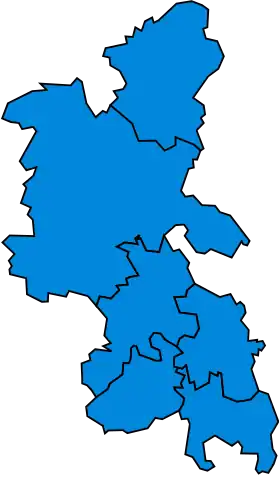 1983
1983 1987
1987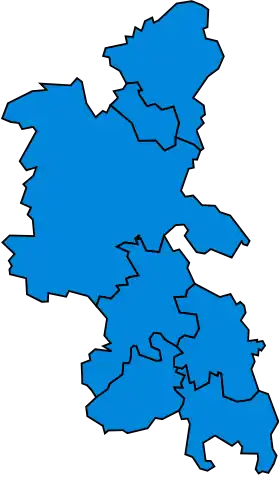 1992
1992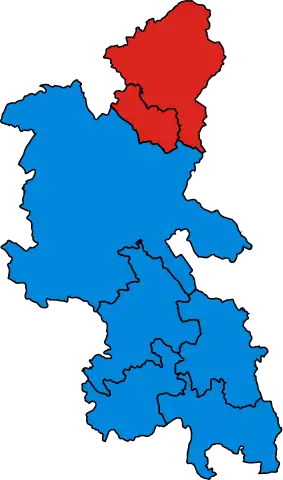 1997
1997 2001
2001 2005
2005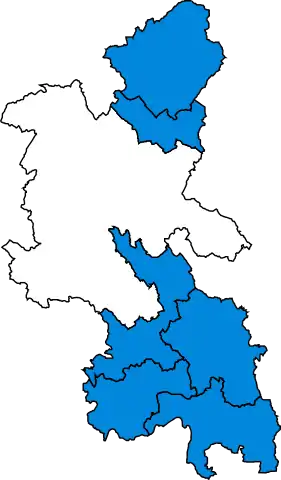 2010
2010 2015
2015 2017
2017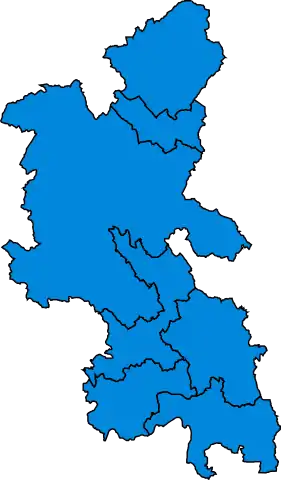 2019
2019
Historical representation by party
A cell marked → (with a different colour background to the preceding cell) indicates that the previous MP continued to sit under a new party name.
1885 to 1945
Conservative Liberal Liberal Unionist
| Constituency | 1885 | 1886 | 89 | 91 | 1892 | 1895 | 99 | 1900 | 1906 | 10 Jan | 10 Dec | 12 | 14 | 1918 | 1922 | 1923 | 1924 | 1929 | 1931 | 1935 | 37 | 38 | 43 |
|---|---|---|---|---|---|---|---|---|---|---|---|---|---|---|---|---|---|---|---|---|---|---|---|
| Aylesbury | F. de Rothschild | → | W. de Rothschild | L. de Rothschild | → | Keens | Burgoyne | Beaumont | Reed | ||||||||||||||
| Buckingham | E. Verney | Hubbard | E. Verney | Leon | Carlile | F. Verney | H. Verney | Bowyer | Whiteley | Berry | |||||||||||||
| Wycombe | Curzon | Grenfell | Herbert | Cripps | du Pré | Woodhouse | Knox | ||||||||||||||||
1945 to 1983
| Constituency | 1945 | 1950 | 1951 | 52 | 1955 | 1959 | 1964 | 1966 | 1970 | Feb 1974 | Oct 1974 | 78 | 1979 | 82 |
|---|---|---|---|---|---|---|---|---|---|---|---|---|---|---|
| Eton and Slough | Levy | Brockway | Meyer | Lestor | ||||||||||
| Aylesbury | Reed | Summers | Raison | |||||||||||
| Buckingham | Crawley | Markham | Maxwell | Benyon | ||||||||||
| Wycombe | Haire | Astor | Hall | Whitney | ||||||||||
| Buckinghamshire South / Beaconsfield (1974) | Bell | Smith | ||||||||||||
| Chesham and Amersham | Gilmour | |||||||||||||
1983 to present
Conservative Independent Labour Speaker
| Constituency | 1983 | 1987 | 1992 | 1997 | 2001 | 2005 | 09 | 2010 | 2015 | 2017 | 19 | 2019 |
|---|---|---|---|---|---|---|---|---|---|---|---|---|
| Aylesbury | Raison | Lidington | Butler | |||||||||
| Buckingham | Walden | Bercow | → | G. Smith | ||||||||
| Wycombe | Whitney | Goodman | Baker | |||||||||
| Beaconsfield | T. Smith | Grieve | → | Morrissey | ||||||||
| Chesham and Amersham | Gilmour | Gillan | ||||||||||
| Milton Keynes / NE Milton Keynes (1992) / MK North (2010) | Benyon | Butler | White | Lancaster | Everitt | |||||||
| Milton Keynes SW / Milton Keynes S (2010) | Legg | Starkey | Stewart | |||||||||
See also
Notes
- BC denotes borough constituency, CC denotes county constituency.
- The majority is the number of votes the winning candidate receives more than their nearest rival.
References
- Baker, Carl; Uberoi, Elise; Cracknell, Richard (28 January 2020). "General Election 2019: full results and analysis". Cite journal requires
|journal=(help) - "Constituencies A-Z - Election 2019". BBC News. Retrieved 24 April 2020.
- "The Parliamentary Constituencies (England) Order 2007". legislation.gov.uk. Retrieved 27 May 2020.
- "Update: Strengthening Democracy:Written statement - HCWS183". UK Parliament. Retrieved 20 April 2020.
- "Parliamentary Constituencies Act 2020".
- "2023 Review launched | Boundary Commission for England". Retrieved 8 January 2021.
- Watson, Christopher; Uberoi, Elise; Loft, Philip (17 April 2020). "General election results from 1918 to 2019". Cite journal requires
|journal=(help)